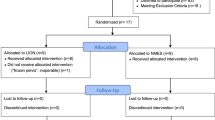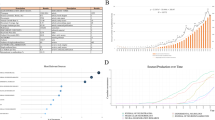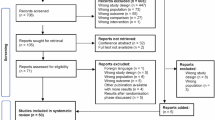Abstract
Study design
Descriptive study.
Objectives
The study’s main objective was to describe the common targets of phenol neurolysis and review the safety and efficacy of the dose used for this spasticity management procedure in people with spinal cord injury (SCI).
Setting
An acute rehabilitation hospital.
Methods
Data from people with SCI who underwent phenol neurolysis procedures for spasticity management between April 2017 and August 2018 were included in this study. We collected demographics and phenol neurolysis procedure-related information.
Results
A total of 66 people with SCI and spasticity underwent phenol neurolysis of 303 nerves over 102 encounters. During these encounters, 97% of procedures were performed using both electrical stimulation and ultrasound guidance. The median (IQR) total volume of 6% aqueous phenol used per encounter was 4.0 (2.0–6.0) ml with a median (IQR) of 1.5 (1.0–2.3) ml per nerve. The most frequent target was the obturator nerve (33%), followed by the pectoral nerves (23%). Immediate post-phenol neurolysis improvement or reduction in spasticity was reported for 92% of all documented encounters. There was no documentation of any post-procedure-related adverse events in this cohort during this specified time frame.
Conclusions
Our findings suggest that phenol neurolysis can be safely used to manage spasticity in people with SCI under combined electrical stimulation and ultrasound guidance. Further research is required to assess the procedure’s safety, efficacy, and cost-effectiveness on patient-reported outcomes compared to other spasticity interventions.
Similar content being viewed by others
Log in or create a free account to read this content
Gain free access to this article, as well as selected content from this journal and more on nature.com
or
Data availability
Additional data are available from the corresponding author on reasonable request.
References
Holtz KA, Lipson R, Noonan VK, Kwon BK, Mills PB. Prevalence and effect of problematic spasticity after traumatic spinal cord injury. Arch Phys Med Rehabil. 2017;98:1132–8.
Maynard FM, Karunas RS, Waring WP 3rd. Epidemiology of spasticity following traumatic spinal cord injury. Arch Phys Med Rehabil. 1990;71:566–9.
Saulino M, Ivanhoe CB, McGuire JR, Ridley B, Shilt JS, Boster AL, et al. Best practices for intrathecal baclofen therapy: patient selection. Neuromodulation. 2016;19:607–15.
Malhotra S, Pandyan AD, Day CR, Jones PW, Hermens H. Spasticity, an impairment that is poorly defined and poorly measured. Clin Rehabil. 2009;23:651–8.
Pandyan AD, Gregoric M, Barnes MP, Wood D, Van Wijck F, Burridge J, et al. Spasticity: clinical perceptions, neurological realities and meaningful measurement. Disabil Rehab. 2005;27:2–6.
Adams MM, Hicks AL. Spasticity after spinal cord injury. Spinal Cord. 2005;43:577–86.
Rekand T, Hagen EM, Gronning M. Spasticity following spinal cord injury. Tidsskr Nor Laegeforen. 2012;132:970–3.
Skold C, Levi R, Seiger A. Spasticity after traumatic spinal cord injury: nature, severity, and location. Arch Phys Med Rehabil. 1999;80:1548–57.
Westerkam D, Saunders LL, Krause JS. Association of spasticity and life satisfaction after spinal cord injury. Spinal Cord. 2011;49:990–4.
Spasticity: diagnosis and management 2nd ed: New York: Demos Medical, 2016.; 2016
Elovic EP, Esquenazi A, Alter KE, Lin JL, Alfaro A, Kaelin DL, et al. Chemodenervation and nerve blocks in the diagnosis and management of spasticity and muscle overactivity. PM R. 2009;1:842–51.
Gracies JM, Elovic E, McGuire J, Simpson DM. Traditional pharmacological treatments for spasticity. Part I: Local treatments. Muscle Nerve Suppl. 1997;6:S61–91.
Kheder A, Nair KP. Spasticity: pathophysiology, evaluation and management. Practical Neurol. 2012;12:289–98.
Msaddi AK, Mazroue AR, Shahwan S, Al Amri N, Dubayan N, Livingston D, et al. Microsurgical selective peripheral neurotomy in the treatment of spasticity in cerebral-palsy children. Stereotact Funct Neurosurg. 1997;69:251–8.
Fan J, Milosevic R, Wang S. Selective peripheral neurotomy (SPN) as a treatment strategy for spasticity. Brain Sci Adv. 2020;6:30–41.
Gonnade N, Lokhande V, Ajij M, Gaur A, Shukla K. Phenol versus botulinum toxin a injection in ambulatory cerebral palsy spastic diplegia: a comparative study. J Pediatr Neurosci. 2017;12:338–43.
Escaldi S. Neurolysis: a brief review for a fading art. Phys Med Rehabil Clin N Am. 2018;29:519–27.
D’Souza RS, Hooten WM. Neurolytic Blocks. StatPearls. Treasure Island (FL)2021.
Felsenthal G. Pharmacology of phenol in peripheral nerve blocks: a review. Arch Phys Med Rehabil. 1974;55:13–6.
Horn LJ, Singh G, Dabrowski ER. Chemoneurolysis With Phenol and Alcohol: A “Dying Art” That Merits Revival. In: Brashear A, Elovic E, editors. New York: Springer Publishing Company; 2015. p. 109-28.
D’Souza RS, Warner NS. Phenol Nerve Block. StatPearls. Treasure Island (FL) 2021.
Zhang B, Darji N, Francisco GE, Li S. The time course of onset and peak effects of phenol neurolysis. Am J Phys Med Rehabil. 2021;100:266–70.
Sung DH, Han TR, Park WH, Je Bang H, Kim JM, Chung SH, et al. Phenol block of peripheral nerve conduction: Titrating for optimum effect. Arch Phys Med Rehabil. 2001;82:671–6.
Halpern D, Meelhuysen FE. Duration of relaxation after intramuscular neurolysis with phenol. JAMA. 1967;200:1152–4.
Akkaya T, Unlu E, Alptekin A, Gumus HI, Umay E, Cakci A, et al. Neurolytic phenol blockade of the obturator nerve for severe adductor spasticity. Acta Anaesthesiol Scand. 2010;54:79–85.
Awad EA. Phenol block for control of hip flexor and adductor spasticity. Arch Phys Med Rehabil. 1972;53:554–7.
Copp EP, Harris R, Keenan J. Peripheral nerve block and motor point block with phenol in the management of spasticity. Proc R Soc Med. 1970;63:937–8.
Karri J, Mas MF, Francisco GE, Li S. Practice patterns for spasticity management with phenol neurolysis. J Rehabil Med. 2017;49:482–8.
Mas MF, DiTommaso C, Li S. Phenol neurolysis for the management of shoulder spasticity in early recovery from traumatic. Brain Injury: A Case Report PM R. 2019;11:90–3.
National Spinal Cord Injury Statistical Center. Spinal Cord Injury Facts and Figures at a Glance. University of Alabama at Birmingham: Birmingham, Alabama. [Internet]. 2019. Available from: https://www.nscisc.uab.edu/Public/Facts%20and%20Figures%202019%20-%20Final.pdf.
Li S, Woo J, Mas MF. Early Use of phenol neurolysis likely reduces the total amount of botulinum toxin in management of post-stroke spasticity. Front Rehab Sci. 2021;2:729178. Published 2021 Sep 16. https://doi.org/10.3389/fresc.2021.729178.
Gaid M. Phenol nerve block for the management of lower limb spasticity. Adv Clin Neurosci Rehab. 2012;12:23–5.
Matsumoto ME, Berry J, Yung H, Matsumoto M, Munin MC. Comparing electrical stimulation with and without ultrasound guidance for phenol neurolysis to the musculocutaneous nerve. PM R 2018;10:357–64.
Kocabas H, Salli A, Demir AH, Ozerbil OM. Comparison of phenol and alcohol neurolysis of tibial nerve motor branches to the gastrocnemius muscle for treatment of spastic foot after stroke: a randomized controlled pilot study. Eur J Phys Rehabil Med. 2010;46:5–10.
Chen CL, Chen CY, Chen HC, Wu CY, Lin KC, Hsieh YW, et al. Responsiveness and minimal clinically important difference of Modified Ashworth Scale in patients with stroke. Eur J Phys Rehabil Med. 2019;55:754–60.
Karen SG, Chua K-HK. Clinical and functional outcome after alcohol neurolysis of the tibial nerve for ankle?foot spasticity. Brain Inj. 2001;15:733–9.
Kong KH, Chua KS. Neurolysis of the musculocutaneous nerve with alcohol to treat poststroke elbow flexor spasticity. Arch Phys Med Rehabil. 1999;80:1234–6.
Kong KH, Chua KS. Intramuscular neurolysis with alcohol to treat post-stroke finger flexor spasticity. Clin Rehabil. 2002;16:378–81.
Shafshak TS, Mohamed-Essa A. Phenol neurolysis for relieving intermittent involuntary painful spasm in upper motor neuron syndromes: a pilot study. J Rehabil Med. 2009;41:201–2.
Yadav SL, Singh U, Dureja GP, Singh KK, Chaturvedi S. Phenol block in the management of spastic cerebral palsy. Indian J pediatrics. 1994;61:249–55.
van Cooten IP, Snoek GJ, Nene AV, de Groot S, Post MW. Functional hindrance due to spasticity in individuals with spinal cord injury during inpatient rehabilitation and 1 year thereafter. Spinal Cord. 2015;53:663–7.
Tibbett J, Widerstrom-Noga EG, Thomas CK, Field-Fote EC. Impact of spasticity on transfers and activities of daily living in individuals with spinal cord injury. J Spinal Cord Med. 2019;42:318–27.
Viel E, Pellas F, Ripart J, Pelissier J, Eledjam JJ. [Peripheral neurolytic blocks and spasticity]. Ann Fr Anesth Reanim. 2005;24:667–72.
Sitthinamsuwan B, Chanvanitkulchai K, Phonwijit L, Nunta-Aree S, Kumthornthip W, Ploypetch T, et al. Surgical outcomes of microsurgical selective peripheral neurotomy for intractable limb spasticity. Stereotact Funct Neurosurg. 2013;91:248–57.
Burns AS, Meythaler JM. Intrathecal baclofen in tetraplegia of spinal origin: efficacy for upper extremity hypertonia. Spinal Cord. 2001;39:413–9.
Felten DL, O’Banion MK, Maida MS. 9 - Peripheral Nervous System. In: Felten DL, O’Banion MK, Maida MS, editors. Netter’s Atlas of Neuroscience (Third Edition). Philadelphia: Elsevier; 2016. p. 153-231.
Acknowledgements
We would like to acknowledge Jonathan Vandenberg, MD for his assistance in data collection.
Author information
Authors and Affiliations
Contributions
RK contributed to the study design, data collection, data analysis, and writing of the manuscript. AM contributed to the data collection, data analysis, and writing of the manuscript. EP contributed to the study design and was responsible for data collection. AS and SL were involved in study design and the manuscript preparation.
Corresponding author
Ethics declarations
Competing interests
The authors declare no competing interests.
Ethical approval
This study was approved by the Institutional Review Board of the University of Texas Health Science Center at Houston.
Additional information
Publisher’s note Springer Nature remains neutral with regard to jurisdictional claims in published maps and institutional affiliations.
Rights and permissions
Springer Nature or its licensor (e.g. a society or other partner) holds exclusive rights to this article under a publishing agreement with the author(s) or other rightsholder(s); author self-archiving of the accepted manuscript version of this article is solely governed by the terms of such publishing agreement and applicable law.
About this article
Cite this article
Korupolu, R., Malik, A., Pemberton, E. et al. Phenol neurolysis in people with spinal cord injury: a descriptive study. Spinal Cord Ser Cases 8, 90 (2022). https://doi.org/10.1038/s41394-022-00556-0
Received:
Revised:
Accepted:
Published:
DOI: https://doi.org/10.1038/s41394-022-00556-0



